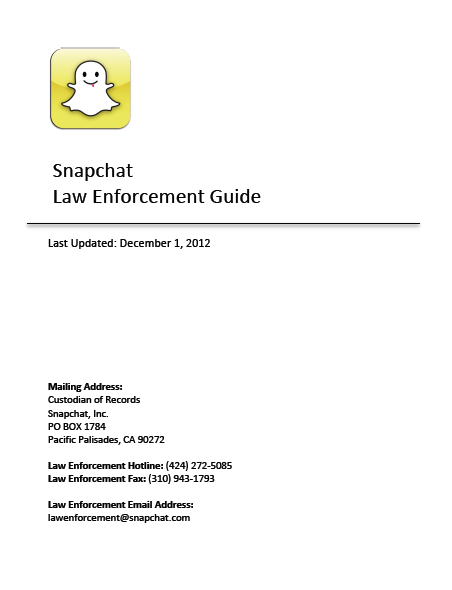

| Visitors Now: | |
| Total Visits: | |
| Total Stories: |
Good-Bye Internet Privacy -The New Big Brother Tool: Snapchat (Video And Law Enforcement Guide)
Monday, October 21, 2013 15:57
% of readers think this story is Fact. Add your two cents.
(N.Morgan) Another tool in the Surveillance Society’s arsenal. This is inner office document details this latest innovation, in the spying on Americans mission,through our cell phones and other technology.
The following guide for law enforcement requests from the online photo-sharing service Snapchat was originally made available in early 2013 on a number of websites related to crimes against children. The guide was later published in June 2013 by Sam Biddle in an article for Valleywag.
Snapchat Law Enforcement Guide
-
10 pages
-
December 1, 2012
I. Snapchat and Law Enforcement
Snapchat is a smart phone application accessed through the iPhone AppStore or Google Play. The application provides a new way to share moments with photos and videos. The purpose of this guide is to familiarize law enforcement agencies with the categories of information available from Snapchat and the specific le8al process necessary to obtain that information.
Snapchat is committed to assisting law enforcement investigations to the fullest extent allowed by applicable law. In addition to this guide, Snapchat also provides phone and email support to law enforcement agencies for both emergency and non-emergency inquiries. Contact information for law enforcement support is listed on the cover of this guide.
The primary set of laws governing Snapchat’s ability to disclose user information is found in the Electronic Communications Privacy Act, 18 U.S.C. § 2701, et seq. (“ECPA”). ECPA mandates that Snapchat may disclose certain user information to law enforcement only in response to specific types of legal process, including subpoenas, court orders, and search warrants. Generally speaking, ECPA permits the disclosure of basic user identity information, login information, and account content (definitions provided in Section IV of this guide) in response to legal process.
Snapchat cannot provide le8al advice to law enforcement officials. As such, should you seek further clarification about ECPA’s requirements and restrictions on providers like Snapchat, we suggest you contact the Department of Justice’s Computer Crime and Intellectual Property Section (CCIPS) at 202-514-1026 and ask to speak to the Duty Attorney.
…
IV. User Records Maintained by Snapchat and the Process Required to Obtain These Records
Snapchat stores the following information for each user:
• Phone number
• Usernarne
• A log of the last 200 snaps that have been sent and received (similar to a phone record)
• Date Account was CreatedSnapchat does not store any image or video data as it is deleted immediately after the recipient views the image or video. If an image or video has not been viewed, it remains on the Snapchat server for 30 days, and then it is removed.
Please note: Snapchat is consistently updating with new features to improve the user’s experience and functionality of the site.
In order to release account records on a non-emergency basis, Snapchat requires proper le8al process in order to provide records. The required legal process for this information is described below in detail.
In addition to including a Snapchat username, please also indicate if results must be returned before a specific date and where results should be returned. Snapchat accepts service via mail, email and fax and will produce documents in response to out-of-state domestic legal process such as subpoenas, court orders, emergency requests, consent letters, and search warrants.Process will be accepted by fax (310-943-1793), by email to [email protected], or by mail (at the address on the cover of this Guide).
a. Subscriber information
Subscriber information is collected when a user creates a new Snapchat account, or alters information at a later date. Please note that not all listed information is required, and that user provided subscriber information is not always independently verified by Snapchat. Subscriber information inc luu des:
• Snapc hat Username (user determines)
• Email address
• Phone Number
. Face 1book account synced
• Log of the last 20o snaps sent and received (similar to phone record)
. Snapchat account creation dateProcess required for subscriber information: subpoena (including grand jury subpoenas), administrative subpoena or civil investigative demand pursuant to 18 U.S.C. 5 2703(c)(2); or court order, or search warrant, or user consent.







It is not the Internet. Two Foo Foo You.
what’s is it then. It uses http.